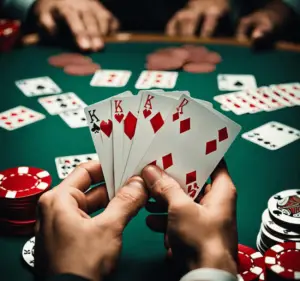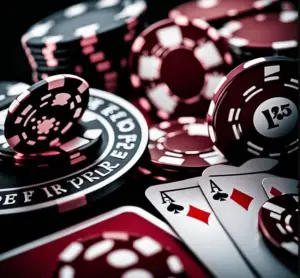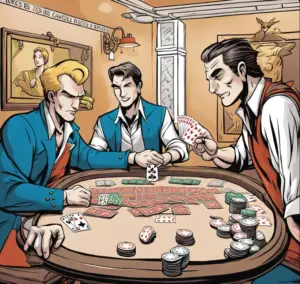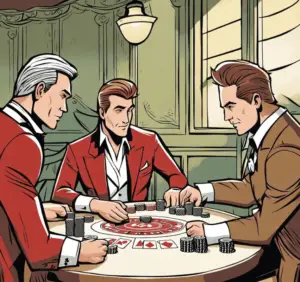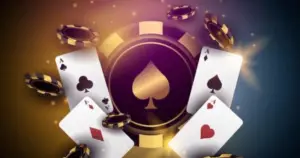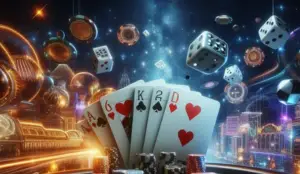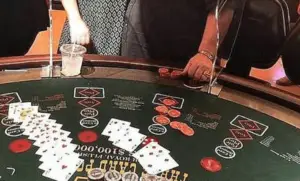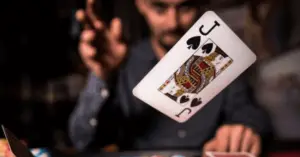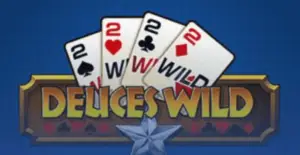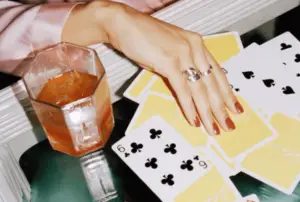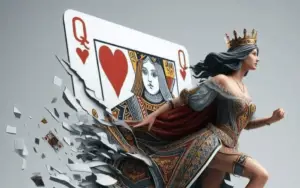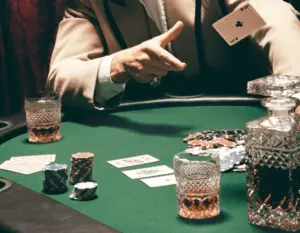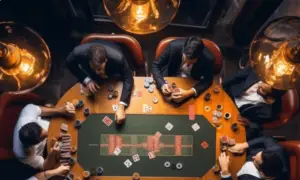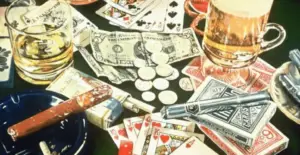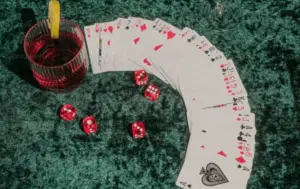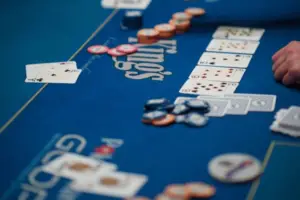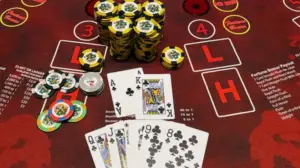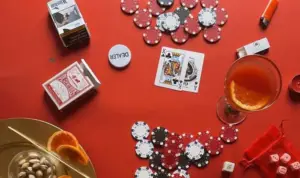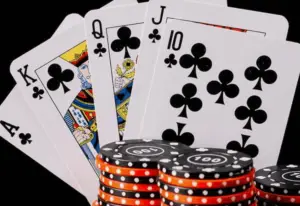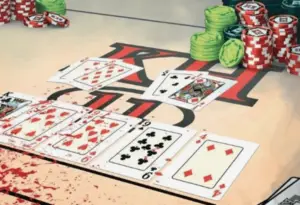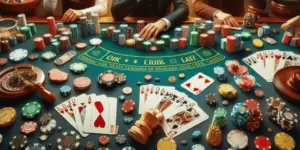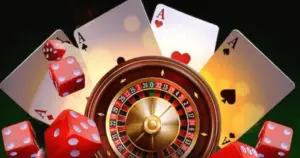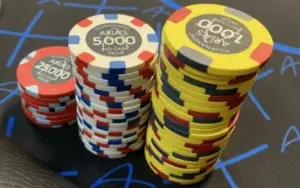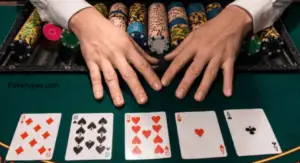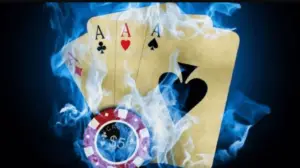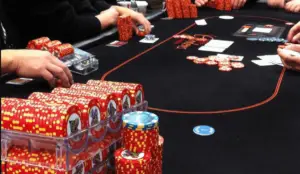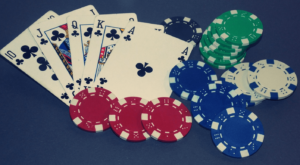Poker has a rich history spanning centuries. From its humble beginnings on the Mississippi River to the glitzy World Series of Poker tournaments, this game has come a long way. Imagine riverboat gamblers in the 1800s playing with just 20 cards, or the thrill when the 52-card deck hit the scene in the 1830s.
Poker’s journey is like a rollercoaster ride, full of twists and turns. It’s gone from smoky back rooms to online platforms where millions play daily.
Did you know that in 2003, an amateur player named Chris Moneymaker won a whopping $2.5 million at the WSOP?
That win sparked a poker boom that’s still going strong today. Whether you’re a pro or just enjoy a friendly game, poker’s story is as fascinating as a royal flush.
Origins and Early Development of Poker
Poker’s roots can be traced back to ancient games like the 10th century Chinese domino-card game and the 16th century Persian game As Nas.
As Nas was played with 25 cards in 5 suits and had similar hand rankings to modern poker, like three-of-a-kind.European predecessors also played a big role in shaping poker.
The 16th-17th century Spanish game Primero, the 17th century French game Poque, and the German game Pochen all contributed to poker’s evolution. Poque and Pochen involved elements of bluffing and betting that are central to poker today.
Poker really started to take off in early 19th century America. French colonists brought Poque to New Orleans, where it was Anglicized to “poker”.
From there, poker spread along the Mississippi River on riverboats, where gambling was a favorite pastime. By 1800, poker was being played throughout the Mississippi River region in various forms using a 52-card deck.
So while poker may have ancient roots in China and Persia, it was the European influence and early development in America that really made it the game we know and love today.
The bluffing from Poque and Pochen, the betting from Primero, and the spread along the Mississippi all laid the foundation for poker to become an American icon.
Evolution of Early Poker (1800s)
A. Transition from 20-card to 52-card deck
In the early 1800s, poker started out as a small-time game using just 20 cards. But as it got more popular, folks wanted to shake things up.
Around 1830, players began using a full 52-card deck. This was a big deal because it let more people join in the fun.
With more cards, you could have bigger games and more exciting hands. It’s like going from a small-town shindig to a big city party!
B. Introduction of the flush
When they switched to the bigger deck, players also added a new winning hand: the flush. This is when all your cards are the same suit, like all hearts or all spades.
The flush made the game more interesting and gave players more ways to win. It was like adding a new secret weapon to your arsenal!
C. Addition of the draw (c. 1850)
Around 1850, poker got even cooler with the addition of the draw. This meant players could swap out some of their cards for new ones. It was a game-changer, folks!
Now, if you had a so-so hand, you could try to make it better. The draw made poker more about skill and less about pure luck. It’s like getting a do-over in the middle of the game!
D. Emergence of stud poker
As if poker wasn’t exciting enough, along came stud poker. This version first showed up during the American Civil War. In stud, some of your cards are face-up for everyone to see.
Talk about nerve-wracking! The most popular type was five-card stud. It added a whole new level of strategy because you could see part of what your opponents had. It’s like playing chess, but with cards!
E. Introduction of wild cards
Last but not least, wild cards joined the party around 1875. These are cards that can stand in for any other card you need. Usually, it was the joker that got to be wild. Wild cards made it easier to get really good hands, like four of a kind or even a royal flush.
It’s like having a secret helper in your hand!All these changes happened pretty fast, in just about 75 years.
Poker went from a simple game with 20 cards to a complex one with lots of different ways to play. It’s no wonder it became America’s favorite card game!
These new rules made poker more exciting, more skillful, and way more fun to play. It wasn’t just about the cards you were dealt anymore.
Now, it was about how you played them, too. Poker became a game where you could bluff your way to victory or outsmart your opponents.
By the end of the 1800s, poker had spread all over the United States. It was played in saloons, on riverboats, and even in fancy parlors.
The game that started out so simple had grown into something that could keep players on the edge of their seats for hours.
And guess what? Poker was just getting started. In the years to come, it would keep changing and growing. New versions would pop up, and poker would become a worldwide phenomenon. But that’s a story for another day!
Popularization and Expansion of Poker
A. Civil War era spread
During the American Civil War(1861-1865), poker really took off. Soldiers from both the Union and Confederate armies played the game to pass time between battles. It was a great way to forget about the tough times and have some fun.
As these soldiers moved around the country, they took poker with them, spreading it like wildfire.The game became so popular that it was played in army camps, on battlefields, and even during breaks in the fighting.
Imagine a bunch of tired soldiers huddled around a makeshift table, playing cards by candlelight! This wartime popularity helped poker become a true American pastime.
B. Frontier and Wild West saloons
After the war, poker found a new home in theWild West. As folks moved out to settle new lands, they brought the game with them.
Saloons became the hot spots for poker games. These weren’t just places to grab a drink – they were like the social hubs of the frontier towns.Picture a dusty saloon in a small western town.
Cowboys, miners, and all sorts of characters would gather around poker tables, trying their luck. The game fit right in with the frontier spirit of taking risks and chasing fortune. It’s no wonder poker became a symbol of the Wild West in movies and books!
C. Introduction to Europe
Poker didn’t stay put in America. It hopped across the pond to Europe in the late 1800s. One of the big names who helped spread the game was General Schenck, the American ambassador to Britain.
In 1872, he taught some fancy English folks how to play during a weekend party.Schenck even wrote down the rules for his new poker buddies.
These rules got printed and passed around, helping more people learn the game. It’s like poker got a VIP pass to high society! Soon, people all over Europe were giving it a try.
D. World War I influence
World War I gave poker another big boost. Just like in the Civil War, American soldiers brought the game with them when they went to fight in Europe.
They taught their Allied buddieshow to play during downtime.When the war ended in 1918, these soldiers went home to countries all over the world. And guess what?
They took their love of poker with them. It’s like poker hitched a ride with the troops and ended up spreading across the globe. This wartime spread helped make poker a truly international game.
It wasn’t just for Americans anymore – people from all sorts of countries were getting in on the action. By the early 1900s, poker had come a long way from its humble beginnings.
It had survived a civil war, tamed the Wild West, crossed an ocean, and even played a part in a world war.
Talk about a wild ride!The game that started out in riverboat gambling halls was now being played in fancy European homes and military camps around the world. Poker had become more than just a card game – it was a part of history and culture in many places.
Modern Developments (20th-21st centuries)
A. Tournament play
In the 20th and 21st centuries, poker tournaments have taken the game to a whole new level. The biggest and baddest of them all is the World Series of Poker (WSOP), which kicked off in 1970.
It’s like the Super Bowl of poker! Over the years, the WSOP has crowned some serious poker legends like Doyle Brunson, Johnny Chan, and Phil Hellmuth. These guys are the rock stars of the poker world.
B. Strategy books and literature
As poker got more popular, people wanted to up their game. That’s where poker strategy books came in. One of the most famous is Doyle Brunson’s Super System, which came out in 1979.
It was like the poker bible! Other big names like Dan Harrington and David Sklansky also wrote books that helped players get better at the game.
C. Television coverage and hole-card cameras
In the early 2000s, poker exploded onTV. Shows like the World Poker Tour and Late Night Poker let fans watch the pros play.
But the real game-changer was the hole-card camera. This nifty invention let viewers see the players’ hidden cards, making the game way more exciting to watch. Suddenly, poker was must-see TV!
D. Online poker
With the rise of the internet, poker went digital. Online poker sites like PokerStars and Full Tilt Poker let people play from the comfort of their own homes.
In the early 2000s, online poker was booming. Amateurs could rub virtual elbows with the pros and win big bucks. It was like the Wild West of poker!
E. Poker variants
WhileTexas Hold’emis still the king of poker, other variants have made their mark in the modern era.
- Texas Hold’em: This is the game you see on TV. Each player gets two hole cards and uses them with five community cards to make the best hand. It’s easy to learn but tough to master.
- Omaha: This game is like Texas Hold’em’s crazy cousin. Players get four hole cards instead of two, but they have to use exactly two of them with three community cards. It’s a wild ride!
- Seven-card stud: This old-school variant was the bee’s knees before Texas Hold’em took over. Players get seven cards (three down, four up) and have to make the best five-card hand. It’s a game of skill and memory.
Poker has come a long way since the days of Wild West saloons. With big-money tournaments, TV coverage, online play, and new variants, the game has evolved into a global phenomenon.
Whether you’re a seasoned pro or just playing for fun, there’s never been a better time to be a poker fan!
Cultural Impact
Poker has made a huge splash in pop culture, showing up in everything from movies and TV shows to books and music.
It’s even turned some of the top players into full-blown celebrities! Folks like Phil Ivey, Daniel Negreanu, and Doyle Brunson are now household names.
The game’s popularity has gone global, with big international tournaments like the World Series of Poker and World Poker Tour drawing players and fans from all over.
The poker boom in the early 2000s, sparked by Chris Moneymaker’s epic WSOP win, made poker a worldwide phenomenon.
Suddenly, everyone wanted a piece of the action! The game’s influence can be seen everywhere, from the poker lingo that’s crept into everyday speech to the countless poker-themed products on the market. It’s clear that poker isn’t just a card game anymore – it’s a full-fledged cultural force.
Legal and Regulatory History
The legal and regulatory history of poker in the United States has been a wild ride. Back in the day, gambling laws were super strict, with most states saying “no way” to any kind of betting. But things started to change in 1988 when the Indian Gaming Regulatory Act hit the scene.
This law let Native American tribes run their own casinos on tribal lands, which was a big deal. Fast forward to the internet age, and online poker became the new hot thing.
But in 2006, the Unlawful Internet Gambling Enforcement Act threw a wrench in the works, making it tough for folks to play poker online.
Since then, it’s been up to each state to decide if they want to let people play online poker. Some states, like New Jersey and Pennsylvania, have given it the green light, while others are still on the fence.
It’s like a poker game itself – you never know what hand you’re gonna get dealt next when it comes to poker laws in the USA!
Conclusion
Poker has come a long way from its humble beginnings on the Mississippi River. It’s grown from a simple card game into a global phenomenon that’s captured the hearts of millions.
From the Wild West saloons to the glitzy World Series of Poker, poker has been there through thick and thin.
It’s survived wars, rode the waves of technology, and even made its way into our living rooms through TV and online platforms. Today, poker isn’t just a game – it’s a part of our culture.
Whether you’re a pro chasing million-dollar pots or just playing with friends for fun, poker’s got something for everyone. It’s a true American success story that keeps on dealing out excitement!


